New-Product Development and Product Life-Cycle Strategies 9 Principles





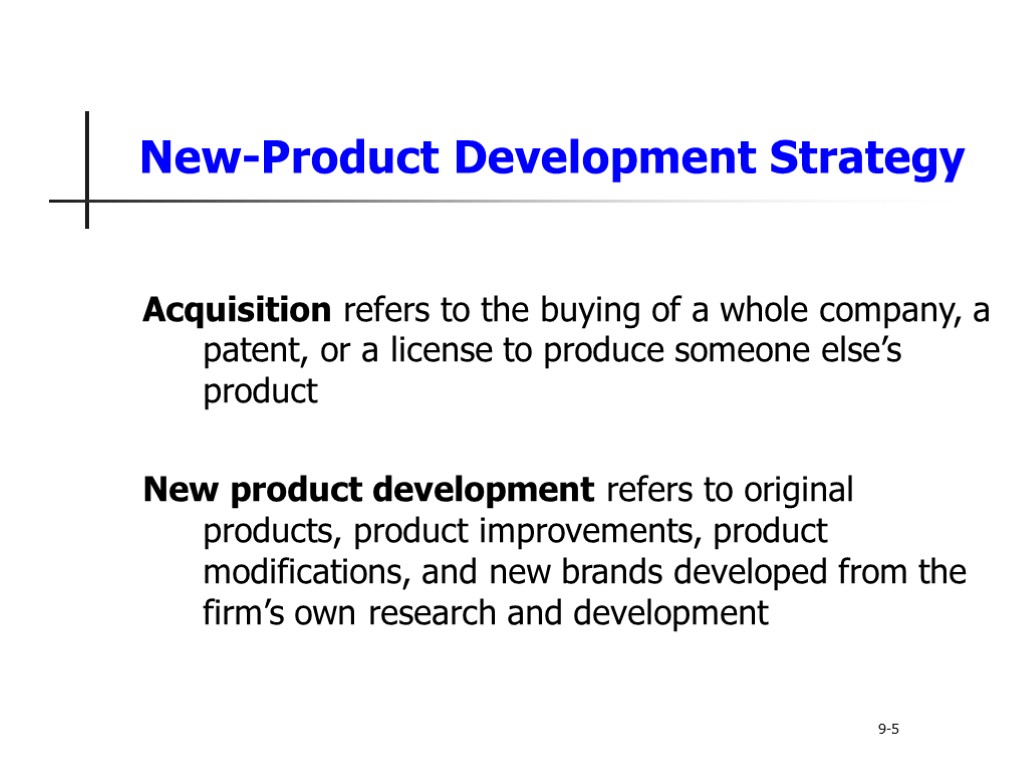

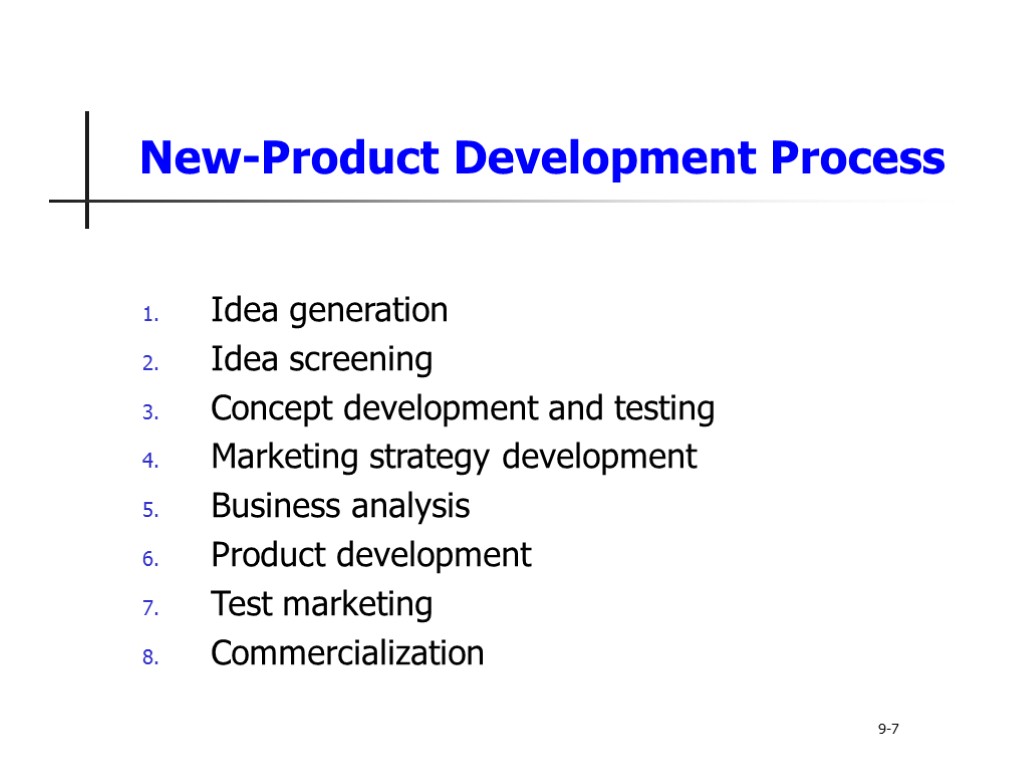


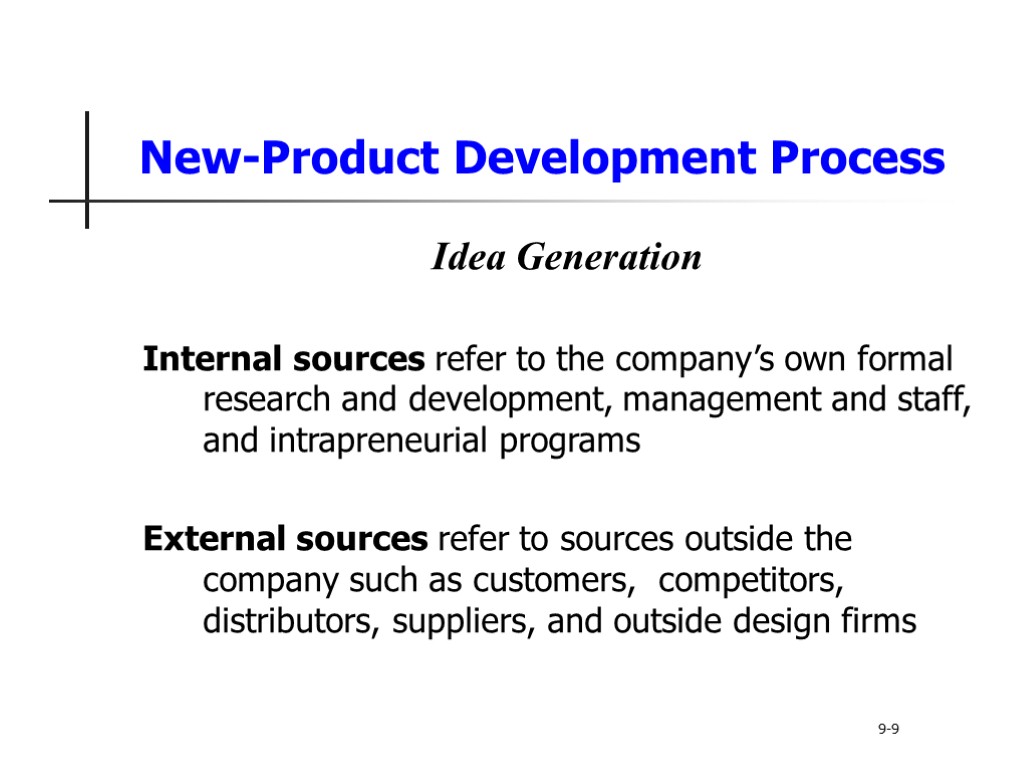





















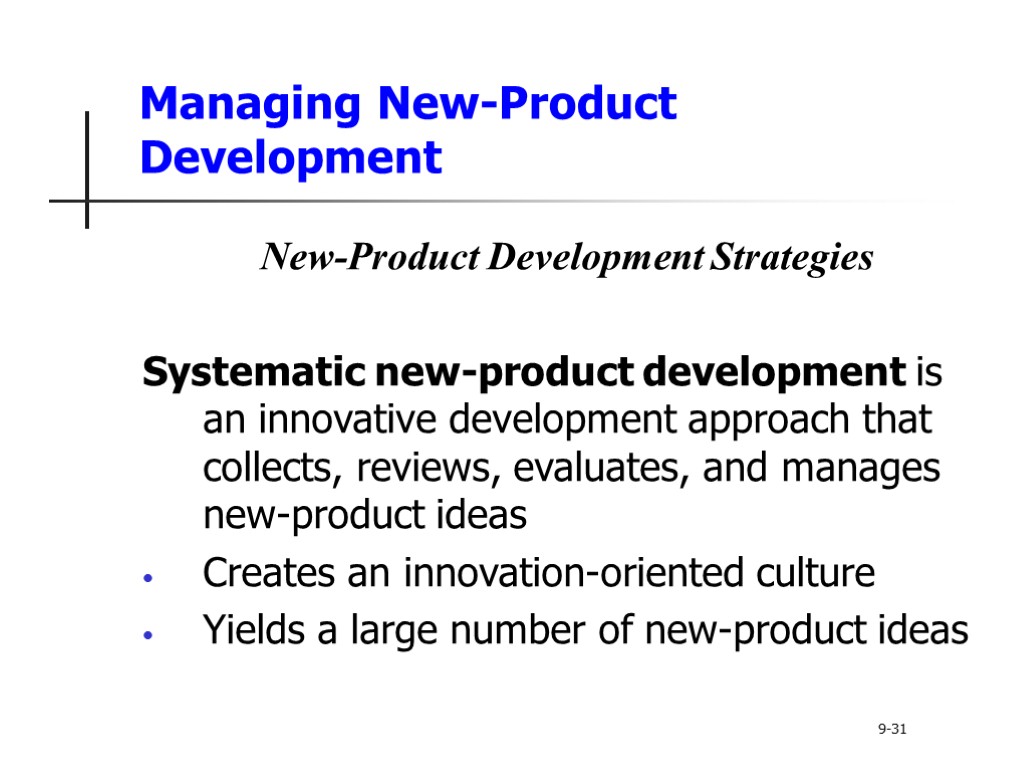








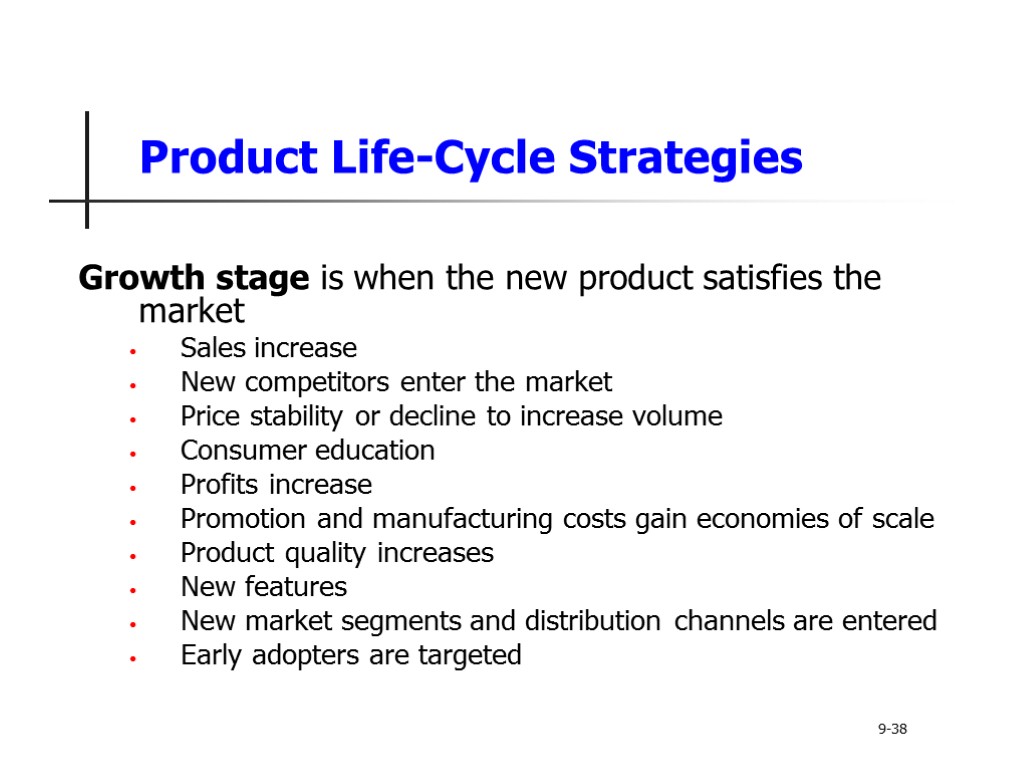



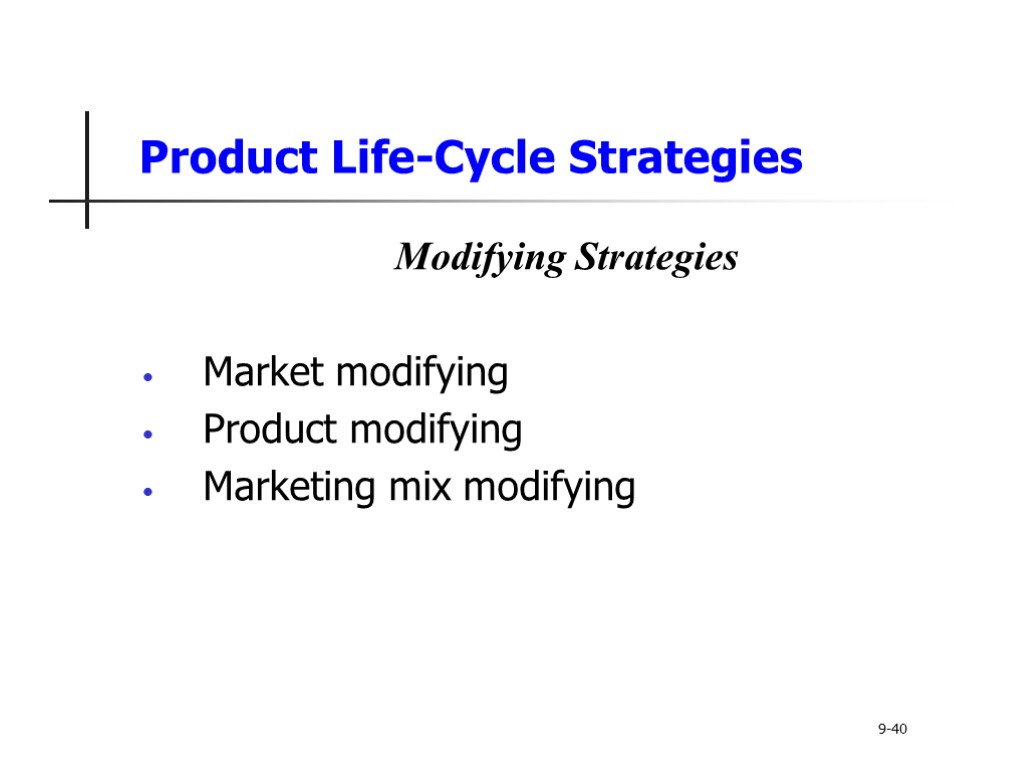

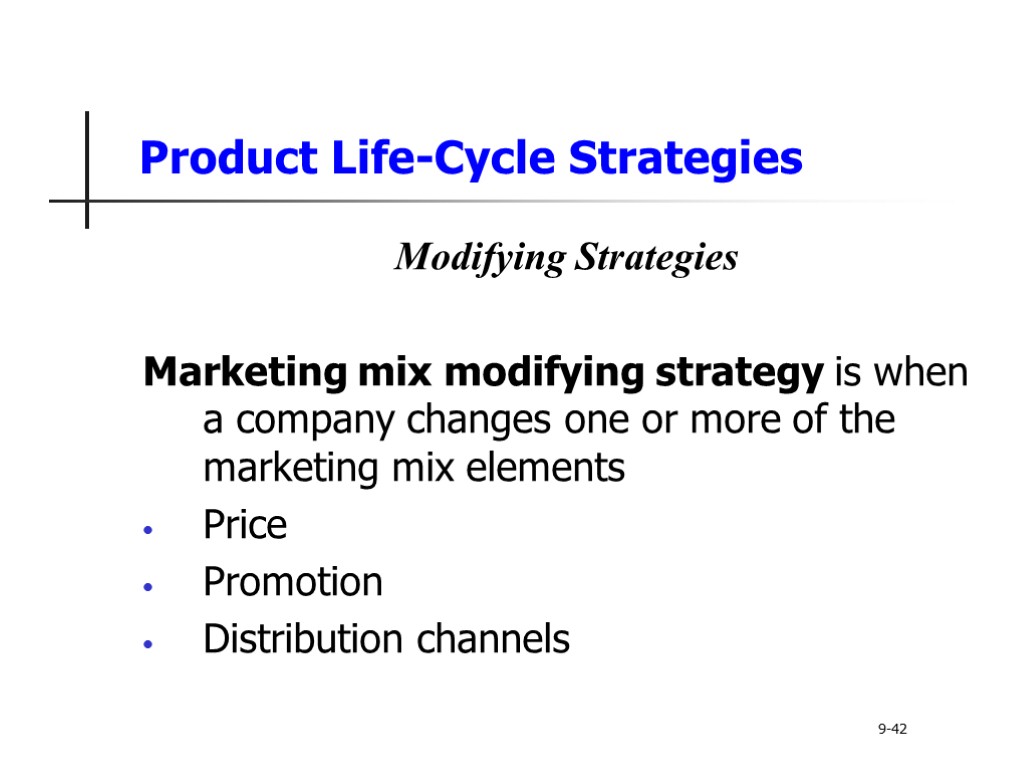




kotler09_exd.ppt
- Количество слайдов: 51
 New-Product Development and Product Life-Cycle Strategies 9 Principles of Marketing
New-Product Development and Product Life-Cycle Strategies 9 Principles of Marketing
 Learning Objectives After studying this chapter, you should be able to: Explain how companies find and develop new-product ideas List and define the steps in the new-product development process and the major considerations in managing this process Describe the stages of the product life cycle Describe how marketing strategies change during the product’s life cycle Discuss two additional product and services issues: socially responsible product decisions and international product and services marketing 9-2
Learning Objectives After studying this chapter, you should be able to: Explain how companies find and develop new-product ideas List and define the steps in the new-product development process and the major considerations in managing this process Describe the stages of the product life cycle Describe how marketing strategies change during the product’s life cycle Discuss two additional product and services issues: socially responsible product decisions and international product and services marketing 9-2
 Chapter Outline New-Product Development Strategy New-Product Development Process Managing New-Product Development Product Life-Cycle Strategies Additional Product and Service Considerations 9-3
Chapter Outline New-Product Development Strategy New-Product Development Process Managing New-Product Development Product Life-Cycle Strategies Additional Product and Service Considerations 9-3
 New-Product Development Strategy A firm can obtain new products through: Acquisition New-product development 9-4
New-Product Development Strategy A firm can obtain new products through: Acquisition New-product development 9-4
 New-Product Development Strategy Acquisition refers to the buying of a whole company, a patent, or a license to produce someone else’s product New product development refers to original products, product improvements, product modifications, and new brands developed from the firm’s own research and development 9-5
New-Product Development Strategy Acquisition refers to the buying of a whole company, a patent, or a license to produce someone else’s product New product development refers to original products, product improvements, product modifications, and new brands developed from the firm’s own research and development 9-5
 New-Product Development Strategy Reasons for new product failure Overestimation of market size Poor design Incorrect positioning Wrong timing Priced too high Ineffective promotion Management influence High development costs Competition 9-6 Buttermilk Shampoo Fruit of the Loom Laundry Detergent
New-Product Development Strategy Reasons for new product failure Overestimation of market size Poor design Incorrect positioning Wrong timing Priced too high Ineffective promotion Management influence High development costs Competition 9-6 Buttermilk Shampoo Fruit of the Loom Laundry Detergent
 New-Product Development Process Idea generation Idea screening Concept development and testing Marketing strategy development Business analysis Product development Test marketing Commercialization 9-7
New-Product Development Process Idea generation Idea screening Concept development and testing Marketing strategy development Business analysis Product development Test marketing Commercialization 9-7
 New-Product Development Process 9-7
New-Product Development Process 9-7
 New-Product Development Process New idea generation is the systematic search for new product ideas Sources of new-product ideas Internal External 9-8 Idea Generation
New-Product Development Process New idea generation is the systematic search for new product ideas Sources of new-product ideas Internal External 9-8 Idea Generation
 New-Product Development Process Idea Generation Internal sources refer to the company’s own formal research and development, management and staff, and intrapreneurial programs External sources refer to sources outside the company such as customers, competitors, distributors, suppliers, and outside design firms 9-9
New-Product Development Process Idea Generation Internal sources refer to the company’s own formal research and development, management and staff, and intrapreneurial programs External sources refer to sources outside the company such as customers, competitors, distributors, suppliers, and outside design firms 9-9
 New-Product Development Process Idea screening refers to reviewing new-product ideas in order to drop poor ones as soon as possible Product development costs increase dramatically in later stages. Ideas are evaluated against criteria; most are eliminated. 9-10 Idea Screening
New-Product Development Process Idea screening refers to reviewing new-product ideas in order to drop poor ones as soon as possible Product development costs increase dramatically in later stages. Ideas are evaluated against criteria; most are eliminated. 9-10 Idea Screening
 New-Product Development Process Concept Development and Testing Product idea is an idea for a possible product that the company can see itself offering to the market Product concept is a detailed version of the idea stated in meaningful consumer terms Product image is the way consumers perceive an actual or potential product 9-11
New-Product Development Process Concept Development and Testing Product idea is an idea for a possible product that the company can see itself offering to the market Product concept is a detailed version of the idea stated in meaningful consumer terms Product image is the way consumers perceive an actual or potential product 9-11
 New-Product Development Process Concept testing refers to new-product concepts with groups of target consumers Product concepts provide detailed versions of new product ideas. Consumers evaluate ideas in concept tests. 9-12 Concept Development and Testing
New-Product Development Process Concept testing refers to new-product concepts with groups of target consumers Product concepts provide detailed versions of new product ideas. Consumers evaluate ideas in concept tests. 9-12 Concept Development and Testing
 New-Product Development Process Marketing Strategy Development Marketing strategy development refers to the initial marketing strategy for introducing the product to the market 9-13
New-Product Development Process Marketing Strategy Development Marketing strategy development refers to the initial marketing strategy for introducing the product to the market 9-13
 New-Product Development Process Marketing Strategy Development Marketing strategy statement Part 1: Description of the target market Product positioning, sales, market share, and profit goals Part 2: Product price, distribution, and marketing budget for the first year Part 3: Long-term sales, profit goals, and marketing mix strategy 9-14
New-Product Development Process Marketing Strategy Development Marketing strategy statement Part 1: Description of the target market Product positioning, sales, market share, and profit goals Part 2: Product price, distribution, and marketing budget for the first year Part 3: Long-term sales, profit goals, and marketing mix strategy 9-14
 New-Product Development Process Marketing Strategy Development Business analysis involves a review of the sales, costs, and profit projections to find out whether they satisfy the company’s objectives 9-15
New-Product Development Process Marketing Strategy Development Business analysis involves a review of the sales, costs, and profit projections to find out whether they satisfy the company’s objectives 9-15
 New-Product Development Process Marketing Strategy Development Product development involves the creation and testing of one or more physical versions by the R&D or engineering departments Requires an increase in investment 9-16
New-Product Development Process Marketing Strategy Development Product development involves the creation and testing of one or more physical versions by the R&D or engineering departments Requires an increase in investment 9-16
 New-Product Development Process Marketing Strategy Development Test marketing is the stage at which the product and marketing program are introduced into more realistic marketing settings Test marketing provides the marketer with experience in testing the product and entire marketing program before full introduction 9-17
New-Product Development Process Marketing Strategy Development Test marketing is the stage at which the product and marketing program are introduced into more realistic marketing settings Test marketing provides the marketer with experience in testing the product and entire marketing program before full introduction 9-17
 New-Product Development Process Marketing Strategy Development When firms test market New product with large investment Uncertainty about product or marketing program When firms may not test market Simple line extension Copy of competitor product Low costs Management confidence 9-18
New-Product Development Process Marketing Strategy Development When firms test market New product with large investment Uncertainty about product or marketing program When firms may not test market Simple line extension Copy of competitor product Low costs Management confidence 9-18
 New-Product Development Process Approaches to test marketing Standard test markets Controlled test markets Simulated test markets 9-19 Marketing Strategy Development
New-Product Development Process Approaches to test marketing Standard test markets Controlled test markets Simulated test markets 9-19 Marketing Strategy Development
 New-Product Development Process Marketing Strategy Development Standard test markets are small representative markets where the firm conducts a full marketing campaign and uses store audits, consumer and distributor surveys, and other measures to gauge product performance. Results are used to forecast national sales and profits, discover product problems, and fine-tune the marketing program. 9-20
New-Product Development Process Marketing Strategy Development Standard test markets are small representative markets where the firm conducts a full marketing campaign and uses store audits, consumer and distributor surveys, and other measures to gauge product performance. Results are used to forecast national sales and profits, discover product problems, and fine-tune the marketing program. 9-20
 New-Product Development Process Marketing Strategy Development Challenges of standard test markets Cost Time Competitors can monitor the test Competitor interference Competitors gain access to the new product before introduction 9-21
New-Product Development Process Marketing Strategy Development Challenges of standard test markets Cost Time Competitors can monitor the test Competitor interference Competitors gain access to the new product before introduction 9-21
 New-Product Development Process Marketing Strategy Development Controlled test markets are panels of stores that have agreed to carry new products for a fee Less expensive than standard test markets Faster than standard test markets Competitors gain access to the new product 9-22
New-Product Development Process Marketing Strategy Development Controlled test markets are panels of stores that have agreed to carry new products for a fee Less expensive than standard test markets Faster than standard test markets Competitors gain access to the new product 9-22
 New-Product Development Process Marketing Strategy Development Simulated test markets are events where the firm will create a shopping environment and note how many consumers buy the new product and competing products. Provides measure of trial and the effectiveness of promotion. Researchers can interview consumers. 9-23
New-Product Development Process Marketing Strategy Development Simulated test markets are events where the firm will create a shopping environment and note how many consumers buy the new product and competing products. Provides measure of trial and the effectiveness of promotion. Researchers can interview consumers. 9-23
 New-Product Development Process Marketing Strategy Development Advantages of simulated test markets Less expensive than other test methods Faster Restricts access by competitors Disadvantages Not considered as reliable and accurate due to the controlled setting 9-24
New-Product Development Process Marketing Strategy Development Advantages of simulated test markets Less expensive than other test methods Faster Restricts access by competitors Disadvantages Not considered as reliable and accurate due to the controlled setting 9-24
 New-Product Development Process Marketing Strategy Development Commercialization is the introduction of the new product When to launch Where to launch Planned market rollout 9-25
New-Product Development Process Marketing Strategy Development Commercialization is the introduction of the new product When to launch Where to launch Planned market rollout 9-25
 Managing New-Product Development Successful new product development should be: Customer-centered Team-centered Systematic 9-26
Managing New-Product Development Successful new product development should be: Customer-centered Team-centered Systematic 9-26
 Managing New-Product Development New-Product Development Strategies Customer-centered new-product development focuses on finding new ways to solve customer problems and create more customer-satisfying experiences Begins and ends with solving customer problems 9-27
Managing New-Product Development New-Product Development Strategies Customer-centered new-product development focuses on finding new ways to solve customer problems and create more customer-satisfying experiences Begins and ends with solving customer problems 9-27
 Managing New-Product Development New-Product Development Strategies Sequential new-product development is a development approach where company departments work closely together individually to complete each stage of the process before passing along to the next department or stage Increased control in risky or complex projects Slow 9-28
Managing New-Product Development New-Product Development Strategies Sequential new-product development is a development approach where company departments work closely together individually to complete each stage of the process before passing along to the next department or stage Increased control in risky or complex projects Slow 9-28
 Managing New-Product Development New-Product Development Strategies Team-based new-product development is a development approach where company departments work closely together in cross-functional teams, overlapping in the product-development process to save time and increase effectiveness 9-29
Managing New-Product Development New-Product Development Strategies Team-based new-product development is a development approach where company departments work closely together in cross-functional teams, overlapping in the product-development process to save time and increase effectiveness 9-29
 Managing New-Product Development New-Product Development Strategies Team-based versus sequential new-product development Team-based can increase tension and confusion Team-based is faster and more flexible 9-30
Managing New-Product Development New-Product Development Strategies Team-based versus sequential new-product development Team-based can increase tension and confusion Team-based is faster and more flexible 9-30
 Managing New-Product Development New-Product Development Strategies Systematic new-product development is an innovative development approach that collects, reviews, evaluates, and manages new-product ideas Creates an innovation-oriented culture Yields a large number of new-product ideas 9-31
Managing New-Product Development New-Product Development Strategies Systematic new-product development is an innovative development approach that collects, reviews, evaluates, and manages new-product ideas Creates an innovation-oriented culture Yields a large number of new-product ideas 9-31
 Product Life-Cycle Strategies Product life cycle (PLC) is the course that a product’s sales and profits take over its lifetime Product development Introduction Growth Maturity Decline 9-32
Product Life-Cycle Strategies Product life cycle (PLC) is the course that a product’s sales and profits take over its lifetime Product development Introduction Growth Maturity Decline 9-32
 Product Life-Cycle Strategies 9-32
Product Life-Cycle Strategies 9-32
 Product Life-Cycle Strategies Product life cycle (PLC) describes: Product class Product form Brand 9-33
Product Life-Cycle Strategies Product life cycle (PLC) describes: Product class Product form Brand 9-33
 Product Life-Cycle Strategies Product classes have the longest life cycles, with sales of many product classes in the mature stage for a long time (soft drinks) Product forms have the standard PLC— shape, introduction, rapid growth, maturity, and decline (diet colas) Brands have changing PLCs due to competitive threats (Diet Dr. Pepper) 9-34
Product Life-Cycle Strategies Product classes have the longest life cycles, with sales of many product classes in the mature stage for a long time (soft drinks) Product forms have the standard PLC— shape, introduction, rapid growth, maturity, and decline (diet colas) Brands have changing PLCs due to competitive threats (Diet Dr. Pepper) 9-34
 Product Life-Cycle Strategies Style is a basic and distinctive mode of expression Fashion is a currently accepted popular style in a given field Fads are temporary periods of unusually high sales driven by consumer enthusiasm and immediate product or brand popularity 9-35
Product Life-Cycle Strategies Style is a basic and distinctive mode of expression Fashion is a currently accepted popular style in a given field Fads are temporary periods of unusually high sales driven by consumer enthusiasm and immediate product or brand popularity 9-35
 Product Life-Cycle Strategies 9-35
Product Life-Cycle Strategies 9-35
 Product Life-Cycle Strategies Introduction stage is when the new product is first launched Takes time Slow sales growth Little or no profit High distribution and promotion expense High cost per customer acquired Innovators are targeted Little competition 9-37
Product Life-Cycle Strategies Introduction stage is when the new product is first launched Takes time Slow sales growth Little or no profit High distribution and promotion expense High cost per customer acquired Innovators are targeted Little competition 9-37
 Product Life-Cycle Strategies Introduction stage Product – Offer a basic product Price – Use cost-plus basis to set Distribution – Build selective distribution Advertising – Build awareness among early adopters and dealers/resellers Sales Promotion – Heavy expenditures to create trial 9-37
Product Life-Cycle Strategies Introduction stage Product – Offer a basic product Price – Use cost-plus basis to set Distribution – Build selective distribution Advertising – Build awareness among early adopters and dealers/resellers Sales Promotion – Heavy expenditures to create trial 9-37
 Product Life-Cycle Strategies Growth stage is when the new product satisfies the market Sales increase New competitors enter the market Price stability or decline to increase volume Consumer education Profits increase Promotion and manufacturing costs gain economies of scale Product quality increases New features New market segments and distribution channels are entered Early adopters are targeted 9-38
Product Life-Cycle Strategies Growth stage is when the new product satisfies the market Sales increase New competitors enter the market Price stability or decline to increase volume Consumer education Profits increase Promotion and manufacturing costs gain economies of scale Product quality increases New features New market segments and distribution channels are entered Early adopters are targeted 9-38
 Product Life-Cycle Strategies Growth stage Product – Offer product extensions, service, warranty, quality improvement Price – Penetration pricing, lower prices Distribution – Build intensive distribution Advertising – Build awareness and interest in the mass market Sales Promotion – Reduce expenditures to take advantage of consumer demand 9-38
Product Life-Cycle Strategies Growth stage Product – Offer product extensions, service, warranty, quality improvement Price – Penetration pricing, lower prices Distribution – Build intensive distribution Advertising – Build awareness and interest in the mass market Sales Promotion – Reduce expenditures to take advantage of consumer demand 9-38
 Product Life-Cycle Strategies Maturity stage is a long-lasting stage of a product that has gained consumer acceptance Slowdown in sales Many suppliers Substitute products Overcapacity leads to competition Increased promotion and R&D to support sales and profits Low cost per customer High or level off profits Middle majority are targeted Competition begins to decline 9-39
Product Life-Cycle Strategies Maturity stage is a long-lasting stage of a product that has gained consumer acceptance Slowdown in sales Many suppliers Substitute products Overcapacity leads to competition Increased promotion and R&D to support sales and profits Low cost per customer High or level off profits Middle majority are targeted Competition begins to decline 9-39
 Product Life-Cycle Strategies Maturity stage Product – Diversify, modify brand and models, increase consumption Price – Set to match or beat competition Distribution – Build more intensive distribution Advertising – Stress brand differences and benefits Sales Promotion – Increase to encourage brand switching, trade deals, premiums 9-39
Product Life-Cycle Strategies Maturity stage Product – Diversify, modify brand and models, increase consumption Price – Set to match or beat competition Distribution – Build more intensive distribution Advertising – Stress brand differences and benefits Sales Promotion – Increase to encourage brand switching, trade deals, premiums 9-39
 Product Life-Cycle Strategies Modifying Strategies Market modifying Product modifying Marketing mix modifying 9-40
Product Life-Cycle Strategies Modifying Strategies Market modifying Product modifying Marketing mix modifying 9-40
 Product Life-Cycle Strategies Modifying Strategies Market modifying strategy is when a company tries to increase consumption of the current product New users Increase usage of existing users New market segments 9-41
Product Life-Cycle Strategies Modifying Strategies Market modifying strategy is when a company tries to increase consumption of the current product New users Increase usage of existing users New market segments 9-41
 Product Life-Cycle Strategies Modifying Strategies Marketing mix modifying strategy is when a company changes one or more of the marketing mix elements Price Promotion Distribution channels 9-42
Product Life-Cycle Strategies Modifying Strategies Marketing mix modifying strategy is when a company changes one or more of the marketing mix elements Price Promotion Distribution channels 9-42
 Product Life-Cycle Strategies Decline stage is when sales decline or level off for an extended time, creating a weak product Declining sales Low cost per customer Declining profits Laggards are targeted Declining competition 9-43
Product Life-Cycle Strategies Decline stage is when sales decline or level off for an extended time, creating a weak product Declining sales Low cost per customer Declining profits Laggards are targeted Declining competition 9-43
 Product Life-Cycle Strategies Decline stage Product – Phase out weak items Price – Cut price Distribution – Use selective distribution: phase out unprofitable outlets Advertising – Reduce to level needed to retain hard-core loyalists Sales Promotion – Reduce to minimal level 9-43
Product Life-Cycle Strategies Decline stage Product – Phase out weak items Price – Cut price Distribution – Use selective distribution: phase out unprofitable outlets Advertising – Reduce to level needed to retain hard-core loyalists Sales Promotion – Reduce to minimal level 9-43
 Additional Product and Service Considerations Product Decisions and Social Responsibility Public policy and regulations regarding developing and dropping products, patents, quality, and safety 9-44
Additional Product and Service Considerations Product Decisions and Social Responsibility Public policy and regulations regarding developing and dropping products, patents, quality, and safety 9-44
 Additional Product and Service Considerations International Product and Service Marketing Challenges Determining what products and services to introduce in which countries Standardization versus customization Packaging and labeling Customs, values, laws 9-45
Additional Product and Service Considerations International Product and Service Marketing Challenges Determining what products and services to introduce in which countries Standardization versus customization Packaging and labeling Customs, values, laws 9-45

